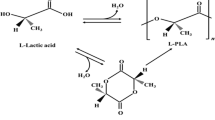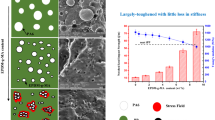Abstract
Heat release capacity is known as a combination of the thermal stability and combustion properties, which can be used to classify the flammability of materials. It can be derived from microscale combustion calorimeter test results or from additive molar group contributions. PMMA and two kinds of extruded polystyrene were tests by microscale combustion calorimeter with 9 heating rates. Heat release capacity was calculated for the tested materials by 5 algorithms from the literatures. Adaptability of these 5 algorithms was evaluated in this paper.
















Similar content being viewed by others
References
Li KY, Pau D, Zhang HP. Pyrolysis of polyurethane foam: optimized search for kinetic properties via simultaneous K–K method, genetic algorithm and elemental analysis. Fire Mater. 2016;40:800–17.
Govmark datasheet of micro-scale combustion calorimeter (MCC2), the Govmark Organization, Inc.
Standard test method for determining flammability characteristics of plastics and other solid materials using microscale combustion calorimetry, ASTM D7309-13, 2013.
Lyon RE, Filipczak R, Walters RN, Crowley S, Stoliarov SI. Thermal analysis of polymer flammability, DOT/FAA/AR-07/2, 2007.
Xiao X, HU S, Zhai JG, Chen T. Thermal properties and combustion behaviors of flame-retarded glass fiber-reinforced polyamide 6 with piperazine pyrophosphate and aluminum hypophosphite. J Therm Anal Calorim. 2016;125:175–85.
Wang WD, Xilei Chen XL, Gu YX, Jiao CM. Synergistic fire safety effect between nano-CuO and ammonium polyphosphate in thermoplastic polyurethane elastomer. J Therm Anal Calorim. 2017;. https://doi.org/10.1007/s10973-017-6724-3.
Shabanian M, Mirzakhanian Z, Moghanian H, Hajibeygi M, Salimi H, Khonakdar HA. Thermal, combustion and optical properties of new polyimide/ODA-functionalized Fe3O4 nanocomposites containing xanthene and amide groups. J Therm Anal Calorim. 2017;129:147–59.
Zhu FL, Xu YF, Feng QQ, Yang QY. Thermal kinetics study and flammability evaluation of polyimide fiber material. J Therm Anal Calorim. 2017;. https://doi.org/10.1007/s10973-017-6752-z.
Xu Q, Jin C, Jiang Y. Compare the flammability of two extruded polystyrene foams with microscale combustion calorimeter and cone calorimeter tests. J Therm Anal Calorim. 2017;127(3):2359–66.
Lyon RE. Heat release capacity. In: Proceedings of the fire and materials conference, San Francisco, CA, January 22–24, 2001.
Walters RN, Lyon RE. Molar group contributions to polymer flammability. J Appl Polym Sci. 2003;87:548–63.
Lyon RE, Walters RN. Heat release capacity: a molecular level fire response parameter. In: Proceedings of the 7th international symposium on fire safety science, intl. assoc. for fire safety science, Worcester, MA, 2003, pp. 1167–1168.
Lyon RE, Walters RN, Stoliarov SI, Safronava N. Principles and practice of microscale combustion calorimetry, DOT/FAA/TC-12/53, 2013.
Xu Q, Jin C, Jiang Y. Analysis of the relationship between MCC and thermal analysis results in evaluating flammability of EPS foam. J Therm Anal Calorim. 2014;118(2):687–93.
Quintiere JG. Fundamentals of fire phenomena. Chichester: Wiley; 2006.
Laachachi A, Cochez M, Ferriol M, Leroy E, Lopez Cuesta JM, Oget N. Influence of Sb2O3 particles as filler on the thermal stability and flammability properties of poly(methyl methacrylate) (PMMA). Polym Degrad Stab. 2004;85:641–6.
Lyon RE, Safronava N, Senese J, Stoliarov SI. Thermokinetic model of sample response in nonisothermal analysis. Thermochim Acta. 2012;545:82–9.
Lin TS, Cogen JM, Lyon RE. Correlations between microscale combustion calorimetry and conventional flammability tests for flame retardant wire and cable compounds. In: International wire and cable symposium, proceedings of the 56th IWCS, Nov 11–14, 2007.
Lowden LA, Hull TR. Flammability behavior of wood and a review of the methods for its reduction. Fire Sci Rev. 2013;. https://doi.org/10.1186/2193-0414-2-4.
Acknowledgements
This research is supported by the Natural Science Fund of China, Nos. 51376093 and 51776098. The research team is honored by “Six Talent Peaks” project of Jiangsu Province, China.
Author information
Authors and Affiliations
Corresponding author
Rights and permissions
About this article
Cite this article
Xu, Q., Jin, C., Majlingova, A. et al. Discuss the heat release capacity of polymer derived from microscale combustion calorimeter. J Therm Anal Calorim 133, 649–657 (2018). https://doi.org/10.1007/s10973-017-6866-3
Received:
Accepted:
Published:
Issue Date:
DOI: https://doi.org/10.1007/s10973-017-6866-3




